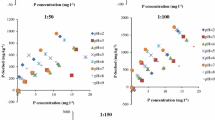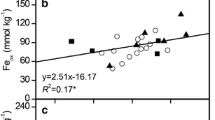Abstract
Purpose
Accumulated soil phosphorus (P) in agricultural lands due to long-term organic manure and mineral phosphate fertilizer input is considered one of the main non-point pollution sources to surrounding surface water bodies. A chronosequence of soils is a potent instrument for pedological investigation and allows assessment of the effect of duration of agricultural cultivation on the environmental risk to water bodies of P loss from soil.
Materials and methods
The present study was conducted to evaluate the impact of pedogenesis on the retention of P in a chronosequence (25, 100, 300, 700, and 2,000 years) of rice paddy soils located on the south bank of Hangzhou Bay. Batch sorption–desorption experiments were performed on the samples of surface horizons from this chronosequence.
Results and discussion
P retention differed moderately among the studied soils ranging from 17.8% to 22.6% when 2,500 mg P kg−1 was added. Subsequent desorption experiment revealed that 11.2% to 21.9% of the recently sorbed P might move into solution. The maximum P sorption capacity as estimated by Langmuir isotherm ranged from 521.9 to 850.9 mg kg−1, with a mean value of 726.2 mg kg−1, while the degree of P saturation was less than 5%. The results indicate that P sorption is influenced by soil development with the maximum sorption capacity of studied soils significantly positively correlated to the organic carbon content of these soil materials.
Conclusions
The pH of the soil decreased from alkaline to neutral with increasing duration of rice cultivation due to continuing decalcification. The organic carbon content in the paddy surface soil materials increased with increasing duration of rice cultivation. The maximum P sorption capacity also slightly increased with increasing duration of rice cultivation likely due to organic carbon accumulation in topsoils. There is a very low risk of P in these paddy soils moving to the surrounding surface water bodies. This study of some possible long-term impacts helps to indicate that rice paddy agriculture is an environment friendly and sustainable land use.



Similar content being viewed by others
References
Barrow NJ (1983) A mechanistic model for describing the sorption and desorption of phosphate by soil. J Soil Sci 34:733–750
Cao ZH (2008) Study of prehistoric irrigated paddys and ancient paddy soils in China. Acta Pedolog Sin 45:784–791 (in Chinese)
Cao ZH, Zhang HC (2004) Phosphorus losses to water from lowland rice fields under rice–wheat double cropping system in the Tai Lake region. Environ Geochem Health 26:229–236
Cao ZH, Lin XG, Yang LZ, Hu ZY, Dong YH, Yin R (2005) Ecological function of “paddy field ring” to urban and rural environment. I. characteristics of soil phosphorus losses from paddy fields to waterbodies with runoff. Acta Pedolog Sin 42:799–804 (in Chinese)
Chen JY, Liu CZ, Zhang CL, Walker HJ (1990) Geomorphological development and sedimentation in Qiantang Estuary and Hangzhou Bay. J Coast Res 6:559–572
Cheng YQ, Yang LZ, Cao ZH, Ci E, Yin SX (2009) Chronosequential changes of selected pedogenic properties in paddy soils as compared with non-paddy soils. Geoderma 151:31–41
Dobermann A, Cassman KG, Mamaril CP, Sheehy JE (1998) Management of phosphorus, potassium and sulfur in intensive, irrigated lowland rice. Field Crops Res 56:113–138
Dossa EL, Baham J, Khouma M, Sene M, Kizito F, Dick RP (2008) Phosphorus sorption and desorption in semiarid soils of Senegal amended with native shrub residues. Soil Sci 173:669–682
Dubus IG, Becquer T (2001) Phosphorus sorption and desorption in oxide-rich Ferralsols of New Caledonia. Aust J Soil Res 39:403–414
Edwards AC, Withers PJA (1998) Soil phosphorus management and water quality: a UK perspective. Soil Use Manage 14:124–130
Gale PM, Reddy KR, Graetz DA (1994) Phosphorus retention by wetland soils used for treated wastewater disposal. J Environ Qual 23:370–377
Gibson WR (1998) Using soil and plant analyses in decisions about fertilizers: a farmer’s perspective. Aust J Exp Agric 38:745–752
Gimsing AL, Szilas C, Borggaard OK (2007) Sorption of glyphosate and phosphate by variable-charge tropical soils from Tanzania. Geoderma 138:127–132
Gong ZT (2003) Chinese soil taxonomy (revised scheme). Science, Beijing
Guo B, Liang YC, Li ZJ, Han FX (2009) Phosphorus adsorption and bioavailability in a paddy soil amended with pig manure compost and decaying rice straw. Commun Soil Sci Plant Anal 40:2185–2199
Gupta RK, Singh Y, Ladha JK, Singh B, Singh J, Singh G, Pathak H (2007) Yield and phosphorus transformations in a rice-wheat system with crop residue and phosphorus management. Soil Sci Soc Am J 71:1500–1507
Heckrath G, Brookes PC, Poulton PR, Goulding KWT (1995) Phosphorus leaching from soils containing different phosphorus concentrations in the Broadbalk Experiment. J Environ Qual 24:904–910
Holford ICR (1979) Evaluation of soil phosphate buffering indices. Aust J Soil Res 17:495–504
Hu JL, Lin XG, Yin R, Chu HY, Wang JH, Zhang HY, Cao ZH (2008) Comparison of fertility characteristics in paddy soils of different ages in Cixi, Zhejiang. Plant Nutr Fertil Sci 14:673–677 (in Chinese)
Huggett RJ (1998) Soil chronosequences, soil development, and soil evolution: a critical review. CATENA 32:155–172
IUSS Working Group WRB (2006) World reference base for soil resources 2006: a framework for international classification, correlation and communication. World soil resources reports No.103, Rome
Lehmann J, Lan Z, Hyland C, Sato S, Solomon D, Ketterings QM (2005) Long-term dynamics of phosphorus forms and retention in manure-amended soils. Environ Sci Technol 39:6672–6680
Li M, Hou YL, Zhu B (2007) Phosphorus sorption-desorption by purple soils of China in relation to their properties. Aust J Soil Res 45:182–189
Lilienfein J, Qualls RG, Uselman SM, Bridgham SD (2004) Adsorption of dissovled organic and inorganic phosphorus in soils of a weathering chronosequence. Soil Sci Soc Am J 68:620–628
Lu RK (2000) Methods of soil and agro-chemistry analysis. Chinese Agricultural Science Press, Beijing
Olila OG, Reddy KR (1993) Phosphorus sorption characterisitics of sediments in shallow eutrophic lakes of Florida. Arch Hydrobiol 129:45–65
Pierzynski GM (1991) The chemistry and mineralogy of phosphorus in excessively fertilized soils. Crit Rev Environ Sci Technol 21:265–295
Ponnamperuma FN (1978) Electrochemical changes in submerged soils and the growth of rice. In: Soils and rice. IRRI, Los Banos, pp 421–441
Schoumans OF, Groenendijk P (2000) Modeling soil phosphorus levels and phosphorus leaching from agricultural land in the Netherlands. J Environ Qual 29:111–116
Sharpley AN, Chapra SC, Wedepohl R (1994) Managing agricultural phosphorus for protection of surface waters: issues and options. J Environ Qual 23:437–451
Sparks DL (1996) Methods of soil analysis: part 3, chemical methods. Soil Science Society of America, Madison
Su JL, Wang KS (1989) Changjiang river plume and suspended sediment transport in Hangzhou Bay. Cont Shelf Res 9:93–111
van Riemsdijk WH, Boumans LJM, de Haan FAM (1984) Phosphorus sorption by soils: I. A model of phosphate reaction with metal oxides in soils. Soil Sci Soc Am J 48:537–541
Villapando RR, Graetz DA (2001) Phosphorus sorption and desorption properties of the spodic horizon from selected Florida spodosols. Soil Sci Soc Am J 65:331–339
Wang QR, Li YC (2010) Phosphorus adsorption and desorption behavior on sediments of different origins. J Soils Sediments 10(6):1159–1173
Wisawapipat W, Kheoruenromne I, Suddhiprakarn A, Gilkes R (2009) Phosphate sorption and desorption by Thai upland soils. Geoderma 153:408–415
Xie XJ, Ran W, Shen QR, Yang CY, Yang JJ, Cao ZH (2004) Field studies on 32P movement and P leaching from paddy soils in the region of Taihu Lake, China. Environ Geochem Health 26:237–243
Zehetner F, Miller WP (2006) Soil variations along a climatic gradient in an Andean agro-ecosystem. Geoderma 137:126–134
Zhang GL, Gong ZT (2003) Pedogenic evolution of paddy soils in different soil landscapes. Geoderma 115:15–29
Zhang ZJ, Zhu YM, Cheng J, Bailey JS (2002) Phosphorus export from a paddy rice field during flood events. Soil Use Manage 18:316–323
Zhang HC, Cao ZH, Shen QR, Wong MH (2003a) Effect of phosphate fertilizer application on phosphorus (P) losses from paddy soils in Taihu Lake region I. Effect of phosphate fertilizer rate on P losses from paddy soil. Chemosphere 50:695–701
Zhang HC, Cao ZH, Wang GP, Zhang HA, Wong MH (2003b) Winter runoff losses of phosphorus from paddy soils in the Taihu Lake region of south China. Chemosphere 52:1461–1466
Zhang YS, Lin XY, Werner W (2003c) The effect of soil flooding on the transformation of Fe oxides and the adsorption/desorption behavior of phosphate. J Plant Nutr Soil Sci 166:68–75
Zhang MK, Zheng SA, Wang LP (2008) Characteristics of phosphorus fixation and release in paddy soils of the Hangzhou-Jiaxing-Huzhou Plain. Acta Agri Shanghai 24:9–13 (in Chinese)
Zhou QX, Zhu YM (2003) Potential pollution and recommended critical levels of phosphorus in paddy soils of the southern Lake Tai area, China. Geoderma 115:45–54
Acknowledgements
A part of the experimental work of this research was completed by the first author when he stayed in Germany (May 2009 to October 2009). The authors express sincere gratitude to Professor Reinhold Jahn in Martin Luther University Halle–Witternberg for his great help and Philipp Roth in University of Bonn for sharing the data. The authors are also grateful to Ms. Hong Lu of the Cixi Agricultural Bureau, Miss Yueqin Cheng of the Institute of Soil Science, Chinese Academy of Sciences, and other members of the Institute of Agriculture and Nutrition Science, Martin Luther University Halle–Witternberg for their great help in soil sampling, experimentation, and valuable discussion about this research. The authors express great appreciation to Professor Yongguan Zhu from the Institute of Urban Environment, Chinese Academy of Sciences, and other two reviewers for valuable suggestions and comments that have greatly improved this manuscript. The authors also express great appreciation to Professor Leigh Sullivan from the Southern Cross University, Australia for the substantial English editing of this manuscript. Financial support from Sino-German Center for Research Promotion Project (GZ518) and the research unit of DFG for 995 is gratefully acknowledged.
Author information
Authors and Affiliations
Corresponding author
Additional information
Responsible editor: Chengrong Chen
Rights and permissions
About this article
Cite this article
Zou, P., Fu, J. & Cao, Z. Chronosequence of paddy soils and phosphorus sorption–desorption properties. J Soils Sediments 11, 249–259 (2011). https://doi.org/10.1007/s11368-010-0301-8
Received:
Accepted:
Published:
Issue Date:
DOI: https://doi.org/10.1007/s11368-010-0301-8




